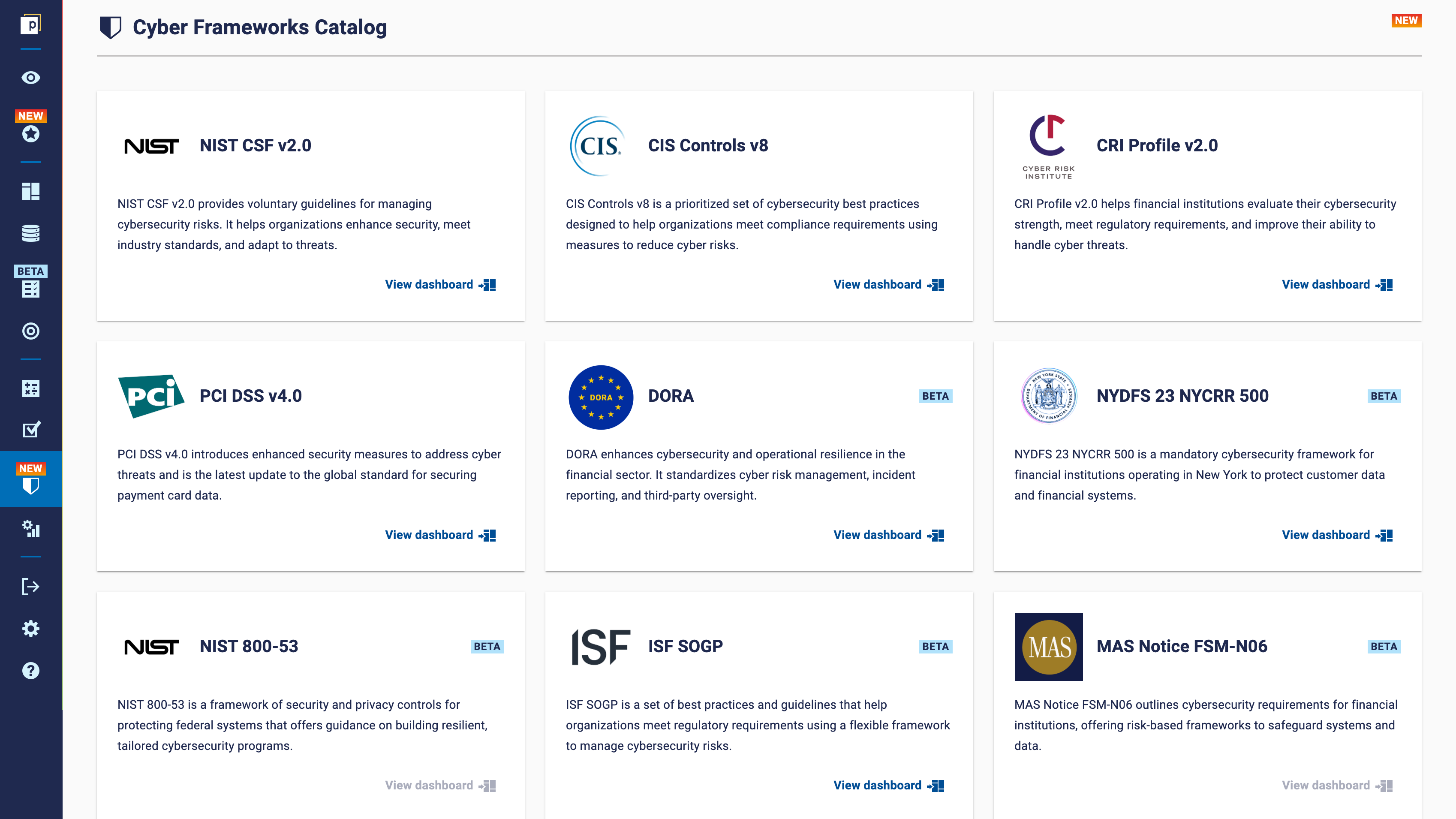
Introducing the Cyber Frameworks Catalog: Turning control visibility into continuous compliance
With the release of the Cyber Frameworks Catalog, Panaseer customers can now spend less time scrambling for audit evidence and more time driving compliance and resilience across the business.
Take a tour of the Frameworks CatalogFor many organizations, audit season doesn’t just bring pressure, it brings disruption. As reporting deadlines loom, security teams are pulled off critical work to gather documentation, validate data, and respond to endless evidence requests. The result? A scramble that stalls projects, drains resources, and forces teams to fight fires rather than focus on actual risk reduction.
Today, Security leaders face a growing burden of compliance, layered by the increasing complexity of hybrid and multi-framework environments. Many remain stuck in reactive mode, chasing evidence, reconciling siloed data, and losing valuable time they can’t afford.
But compliance is no longer periodic. It’s continuous. And meeting today’s demands isn’t about adding more people or more tools but about having real-time visibility into control effectiveness. That’s why we’ve developed a way to continuously measure compliance, so organizations can respond faster to regulatory requirements, reduce risk proactively, and build trust through transparent, agile reporting.
Introducing the Cyber Frameworks Catalog
Features of the Cyber Frameworks Catalog
Panaseer’s Cyber Frameworks Catalog uses control measurement and continuous monitoring to deliver compliance, making it a seamless, always-on process.

Here’s how it works.
Pre-built compliance dashboards
We offer ten pre-built dashboards covering over 200 control metrics aligned with major cybersecurity frameworks, including NIST CSF v2.0, CIS v8, PCI DSS v4.0, and the CRI Profile v2. In addition, DORA, is supported through a dedicated dashboard with tailored metrics. These dashboards provide security and GRC teams with a real-time, comprehensive view of compliance and control effectiveness, all aligned with leading industry standards.
Teams can inspect the data for demonstrable evidence of compliance performance, with heat maps highlighting critical control failures. This ensures that teams can prioritize the most important areas during audits. The dashboards are continuously updated in real time, keeping security teams equipped with the latest information and eliminating the need for periodic, point-in-time audits.
Automated cross-framework mapping
Enterprise organizations often need to map multiple regulations and frameworks across different business units and geographies, a process that’s complex and prone to error when done manually.
Panaseer’s Cyber Frameworks Catalog automates control mapping, aligning security controls with standards like PCI-DSS, DORA, and other supported frameworks across the organization. This streamlines compliance by showing where a single control satisfies multiple framework requirements at once.
Actionable insights into control gaps
The Panaseer platform helps security teams proactively identify and address control gaps with real-time alerts and detailed dashboards. Configurable thresholds notify teams immediately when a control fails, enabling quick root cause analysis.
With continuous, automated insights, compliance is no longer reliant on periodic reviews. Teams can address control failures in real-time, minimizing exposure and ensuring ongoing alignment with relevant frameworks. This shift from reactive audits to continuous visibility transforms compliance into an always-on, business-as-usual process.
Business-relevant reporting at scale
We consolidate data from individual framework dashboards into a compliance scorecard, providing continuous visibility into compliance performance across business units, geographies, and regulatory regimes.
The scorecards allow teams to track trends, pinpoint areas of concern, and focus on specific regions or frameworks. With this level of granularity, stakeholders, from 1st, 2nd, and 3rd line can access relevant insights to drive decisions or ensure alignment with both regulatory demands and business goals.
Why is continuous compliance so important?
Compliance isn’t just getting harder, it’s getting faster. Standards like PCI DSS v4.0 and NIST CSF 2.0 are no longer satisfied with annual check-ins. They now explicitly call for ongoing control monitoring and sustained visibility into risk posture.
In financial services, DORA has made real-time ICT risk monitoring mandatory across EU institutions. These changes aren’t theoretical; they’re structural shifts that redefine how compliance must be managed moving forward.
The consequences for falling short are only getting more severe. In 2024 alone, the SEC issued over $600 million in fines tied to recordkeeping failures, part of an enforcement wave that’s already passed $2 billion since 2021. The same year, Meta was hit with a €251 million fine under GDPR, proof that regulators aren’t just watching, they’re acting. Whether it’s SOX, PCI, NYDFS, or GDPR, expectations are rising, and so are the costs of non-compliance.
Traditional approaches simply can’t keep up. Manual processes, static assessments, and siloed data mean that by the time audits roll around, teams are left scrambling. Internal audit groups have reported delays of up to 60% just preparing evidence, often due to fragmented tooling and reactive reporting. And in highly regulated industries, that delay doesn’t just slow things down, it becomes a real business risk.
That’s why continuous compliance matters. It means being able to prove, at any time, that your controls are in place, working, and aligned to the right frameworks. Instead of reacting to audits, you're always ready for them. Instead of chasing evidence, you’ve already got it. It’s a shift from point-in-time reporting to real-time assurance, and it’s the only way to keep pace with modern regulatory expectations.
With continuous compliance, teams gain real-time visibility into how controls are performing and where gaps are emerging before they become exposures. It’s about moving from firefighting to foresight, from one-off checks to always-on assurance. And ultimately, it’s about staying compliant without sacrificing security or slowing the business down.
Final thoughts
Meeting compliance requirements shouldn’t feel like chasing a moving target, and with Panaseer’s Cyber Frameworks Catalog, it doesn’t have to. Whether you're managing multiple frameworks across global teams or trying to stay ahead of audit deadlines, we give you the clarity and confidence to make compliance part of everyday operations, not a last-minute scramble.
If you want to see the Frameworks Catalog in action, book a demo with us today.


